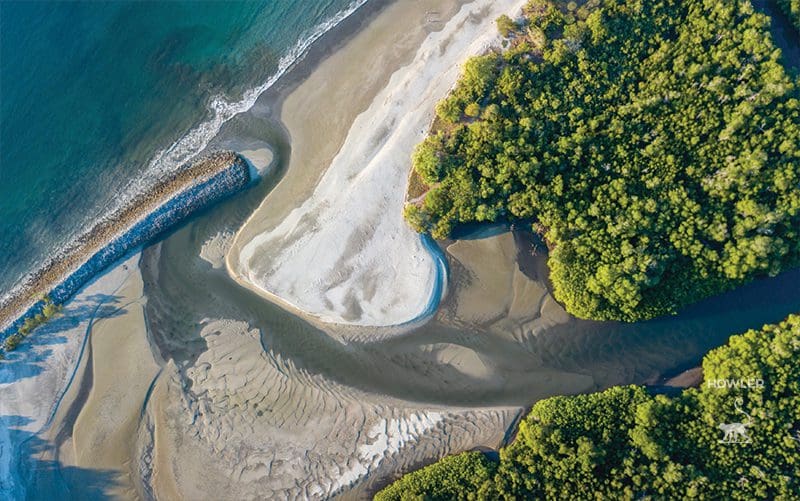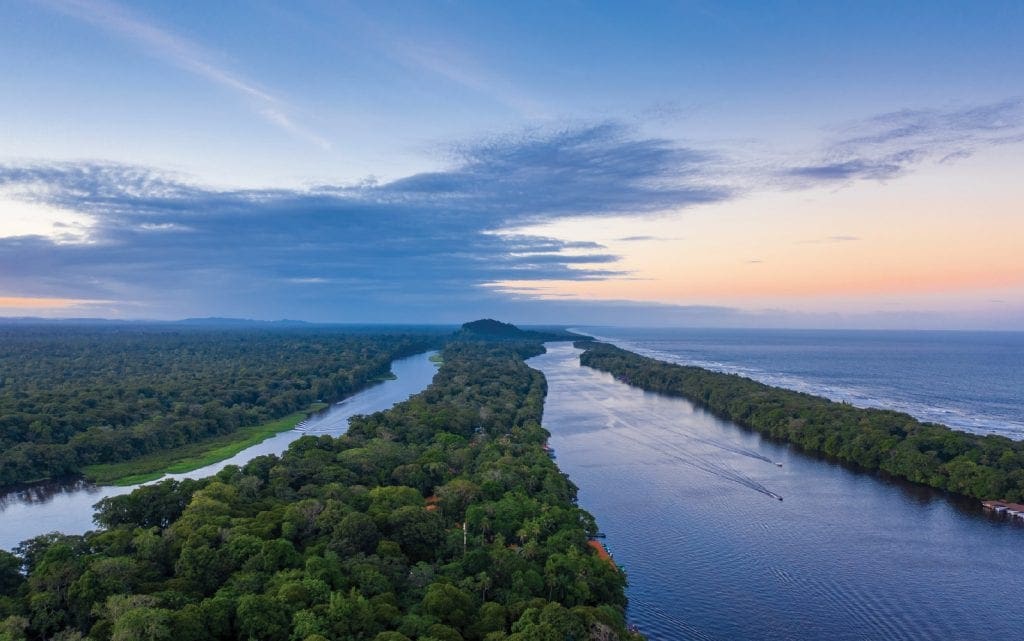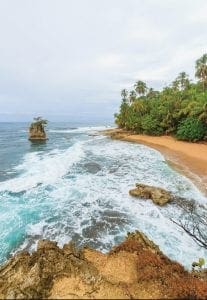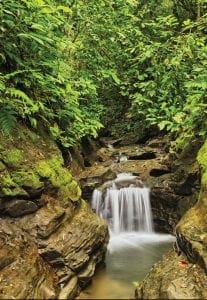
Where the Rivers Meet the Sea
Above Photo Caption: Playa Cabuyal in the Gulf of Papagayo, Guanacaste. Where the Rivers Meet the Sea: Waterways in Costa Rica. Costa Rica is blessed with a sturdy backbone, the Cordillera Central Mountain Range running north and south through the center of the country. Being close to the equator, Costa Rica receives a lot of rainfall, so this “backbone” serves an important purpose. The mountain range helps distribute vast amounts of fresh water to the east, where it eventually empties into the Caribbean Sea, or to the west and the shores of the Pacific Ocean.
The result is a veritable spider web of waterways that meander throughout the land before ultimately converging with the salty oceanic waters. Each of these intersecting spots where the river meets the sea is a fascinating world unto itself.
Webster’s dictionary defines “estuary” simply as “an arm of the sea that ebbs at the lower end of a river.” Many of Costa Rica’s unique river mouths have been relegated as refuge areas within the national park system.
Each of these intersecting spots
where the rivers meet the sea
is a fascinating world unto itself.

Aerial view of Tortuguero, from south to north
Refuge for rare species
The Sixaola River creates part of the border between Costa Rica and Panama, originating in the Cordillera and emptying into the Caribbean Sea. The river is also the southern boundary of the Gandoca Manzanillo Wildlife Refuge, 23,000 acres classified as humid tropical rainforest, accommodating a 10-kilometer strip of Caribbean beachfront. This refuge houses the only known orey and jolillo pond swamps in Costa Rica, as well as the only natural oyster beds in the Caribbean reefs that extend all the way to Cahuita.
This small village is the historic birthplace of Walter Ferguson, “Father of Calypso,” who still performs there on occasion. The park is a natural habitat for the harpy eagle, mot-mots and toucans. Marine life in the crystal-clear reefs includes anemones, blue parrot fish, sea cucumber and angel fish — a dream come true for snorkelers.
This area is also becoming more widely known for the Salsa Brava surf break south of Puerto Viejo and Playa Cocles, just outside Cahuita. Gaining in popularity, it is a “secret spot” no more, as businesses crop up to accommodate the surfing culture. Although the area receives year-round rainfall, September and October are typically drier, making it a good time to visit. This seasonal pattern is inconsistent with the rest of Costa Rica, where those two months are normally the rainiest.
Indiana Jones experience
On the north end of Costa Rica’s Caribbean shoreline is Barra de Colorado Wildlife Refuge, established in 1982. It embraces a massive 225,000 acres, bordering Nicaragua with the San Juan River. This verdant primary forest, unscathed, is inaccessible by road. With no buses or public transportation options, it can be reached only by private riverboat, seafaring ships or the tiny gravel airstrip next to the Colorado River. Be ready for a real-life Indiana Jones experience!
In a country full of natural wonders, Barra de Colorado is truly an isolated, pristine paradise. Fishing is a major draw to the region, including trophy tarpon, snook and rainbow bass in the freshwater rivers and barracuda, mackerel and jack crevalle offshore. Averaging an incredible 234 inches of rainfall per year, it’s also a favorite destination for kayakers, canoers, photographers and birders. Proximity to the Rio Colorado, Rio San Juan and the raging Rio Chirripo makes this a prime locale for long-billed birds such as the glossy ibis, wood stork, snail kite, green-backed heron and black-necked stilt.
Weather patterns dictate water distribution, so historically, Costa Rica’s Caribbean side has received more rainfall than the Pacific side. But that doesn’t mean the western half of the country is arid.
Nicoya wonderlands

Playa Manzanillo, where the Sixaola River creates part of the border between Costa Rica and Panama.
The Nicoya Peninsula’s southwestern tip has become a “discovered” secret surf spot, especially the Santa Teresa – Malpais stretch of beach. Just to the north lies the Rio Bongo Estuary, part of the immense Caletas Ario Wildlife Refuge. The 775-acre natural preserve includes seven kilometers of pristine beachfront. This impressive parcel of land was donated in 2008 by the Grew family from Canada.
Forming the border between Guanacaste and Puntarenas provinces is the Rio Bongo. It is the largest river on the Nicoya Peninsula, joined very near the estuary mouth by the Rio Ario and Rio Cano Seco.
As one of Costa Rica’s most important turtle nesting sites, the beaches here support four species: leatherback and the common Olive Ridley and Pacific green, as well as the rare hawksbill. To curtail the longstanding problem of poaching turtle shells and eggs, CIRENAS (Centro de Investigacion de Recourses Naturales) has recently stepped in. This independent organization operates within the refuge. It focuses on research and education related to water conservation and management, sustainable food production and ecologically viable housing.
Playa Manzanillo is one of the largest communities in this area. If you are visiting in the month of March, be sure to participate in the annual Sandcastle Beach Party.

A coastal entryway to Corcovado National Park
Waves, waterfalls and wildlife
Further south down the Costa Rica coastline is the town of Pavones, where a series of small beaches are interspersed with rocky coastline. But the surf is good here, as it is at Playa Zancudo and Punto Banco, each a few miles to the north and south, respectively.

Tiskita Falls, near the Pacific coastline at Pavones
Pavones is home to several waterfalls within beach view, including Tiskita, boasting a drop of more than 100 feet. The Rio Claro empties in the ocean here, at Golfo Dulce, creating the biological wonderland of Piedras Blancas National Park. Formerly part of the legendary Corcovado National Park, it is home to the self-sufficient indigenous Guaymi people, who often bring their handmade crafts into Pavones to sell. The area receives more than 200 inches of rain a year, so be sure to bring your umbrella.
Estuaries in the small country of Costa Rica are plentiful, and most are being watched now with a mindfully protective eye. So many species of flora and fauna exist primarily — if not only — in these wondrous locales. For the sake of future generations, your personal integrity and the planet’s wellbeing, do remember to be respectful when visiting any of them.
